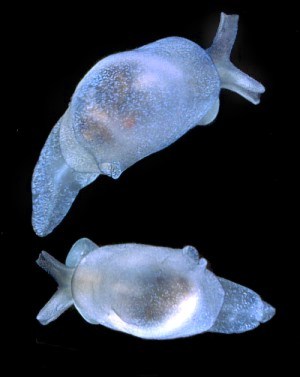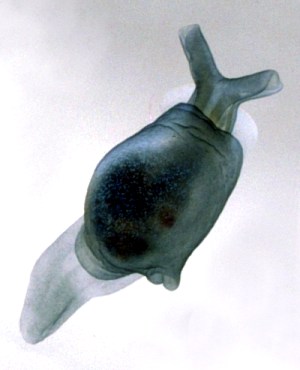

Colpodaspis sp. 1
Order: CEPHALASPIDEA
Superfamily: DIAPHANOIDEA
Family: Diaphanidae
PHOTO
Bicheno, 15 m, eastern Tasmania, Australia. May 1985. 5 mm long alive. AM C146542. Photos: Bill Rudman
Ths small greyish white opisthobranch has a fragile shell completely enclosed in a thin layer of mantle. It has a pair of enrolled rhinophores which draw water back into the mantle cavity, and a single exhalent siphon on the posterior right side of the body. The white specks which can be seen all over the body and foot are subcutaneous mantle glanfs which produce a milky secretion when the animal is disturbed. There is an accessory pedal gland in the middle of the foot which produces a sticky secretion presumably to assist the tiny slug to stay attached to the substrate. This species is very similar externally to the British Colpodaspis pusilla but differs in having a much longer foot extending some distance behind the end of the shell. A rounded flap of tissue can be seen lying on the foot at the posterior end of the shell. This is an extension of the mantle. In C. pusilla the posterior foot is very short, and from above is completely obscured by this mantle flap which in that species is much wider and longer.
The dark grey-blue animal and the upper white one are in fact the same specimen. The difference in colour is a result of photographing the animal on white and black backgrounds. The animal has not changed colour it is some optical phenomenon I do not understand.
-
Brown, G.H. (1979) An investigation of the anatomy of Colpodaspis pusilla (Mollusca: Opisthobranchia) and a description of a new species of Colpodaspis from Tanzanian coastal waters. Journal of Zoology, London, 187: 201-221.
Rudman, W.B., 2000 (June 17) Colpodaspis sp. 1 [In] Sea Slug Forum. Australian Museum, Sydney. Available from http://www.seaslugforum.net/factsheet/colpsp1
